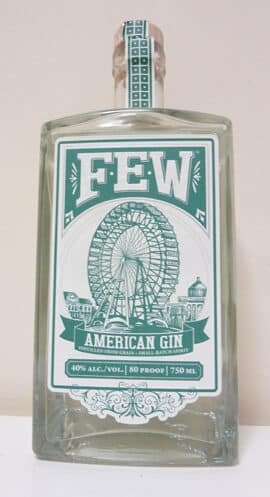Few American Gin is not a Genever. But it is not a normal gin. In fact, I sometimes think that Few and the other few gins mentioned above should be considered their own category. If you like gins with the malty, warm, whiskey like base, you’re going to like Few America Gin. If you like Beefeater, but dislike whiskey- perhaps Few American Gin is not for you.
Few uses a base closer to a “white dog,” or white whiskey. This means that although it can be considered “neutral” in some sense of the word, it carries with it a distinct warming, toasty, almost grain-like flavor to the cocktail.
We’ve commented on this a great deal in the past. Other gins, such as Ingenium Gin, St George’s Dry Rye Gin and Smooth Ambler’s Greenbrier Gin have come at gin from this similar angle. In the late 2010’s, the term Holland-Style has gained some traction as a way of referring to this style; however, there is no critical consensus yet.
Tasting Notes
Aroma: The nose is perhaps as malty as you might expect. That warm woodsy nose is surely present and a bit of a giveaway as to the base. The nose doesn’t reveal much more of the gin. No hints of coriander nor juniper. No wafts of citrus.
Flavor: When you do get down to taking a sip, you do begin to appreciate that there is much more going on here than just a novel base. You can pick up notes of lemon meringue pie, with burnt tips suggesting warm spicy quality. A little bit toasty, a little bit burnt. I’d say there’s a hint of cinnamon in Few American Gin with the lemon in here and a long mellow finish. Lots of juniper and even some vanilla.
One interesting note that you can pick out in the midst of the burn and malty character is a touch of bitterness, which I had initially thought reminded me of the sensation that strong IPA brings to your mouth after a sip. Considering that Hops are among the botanical list, this might not be so far off base.
Cocktails and suggested serves
Sometimes I worry that this might be the impetus for creating or dubbing this a new style. Simply enough, the list of cocktails that they work in (and don’t work in) are roughly similar. I’m not crazy about the grain base works in a Tom Collins. If it were a little bit more pronounced, it might come out like a white whiskey sour.
The Negronis are stunning.
Few American Gin is smooth, a bit hot, but still quite drinkable. I think with a good vermouth pairing, its a rather remarkable martini. And its hard to go wrong in a gin and tonic, and Few does not disappoint. Pair it with a bitter tonic like Q, add a bit of lime, and you have a cool and refreshing Gin and Tonic, albeit one which is quite different than your usual.
Overall, Few American Gin
Rich in flavor and with sufficient depth to warrant sipping on its or mixing in cocktails where it is the star, it will probably appeal to gin drinkers who are already converted to the “Genever-like” style of gin. But then again, I think that if you know a whiskey drinker who doesn’t like drink, this might be right up their alley.

